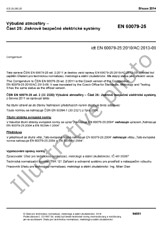We need your consent to use the individual data so that you can see information about your interests, among other things. Click "OK" to give your consent.

IRS 70778-2-2ed.
Recommendations for determining the carrying capacity and fatigue risks of existing metallic railway bridges
Translate name
STANDARD published on 1.5.2020
The information about the standard:
Designation standards: IRS 70778-2-2ed.
Publication date standards: 1.5.2020
SKU: NS-993755
The number of pages: 77
Approximate weight : 231 g (0.51 lbs)
Country: International technical standard
Category: Technical standards IRS
Annotation of standard text IRS 70778-2-2ed. :
This IRS is the evolution of UIC Leaflet 778-2 "Recommendations for determining the carrying capacity of existing metal structures", 1st edition, July 1986.
The recommendations in this IRS are intended to be used for determining the load carrying capacity, serviceability and fatigue risks of existing wrought iron and steel bridges considering real traffic loading and the condition of the structure for:
- - Normal rail traffic on the standard track gauge European network for normal situations (persistent situations);
- - The assessment of normal types of metallic bridges made with wrought iron, early steels and more modern steels under normal rail traffic loading.
This IRS does not cover the requirements for:
- - Steam engines (in particular the static loading and dynamic load effects due to lurching and hammer blow);
- - Special checks where there is a risk of excessive dynamic effects including resonance;
- - Cast iron parts of bridges;
- - Transient situations, e.g. operation of engineering trains and cranes on a rail bridge;
- - Accidental and seismic situations;
- - Some extreme weather situations, for example hydraulic actions due to floods.
This IRS is not applicable to the design of new bridges. This IRS uses a more precise safety concept without allowances for future growth in the weight and speed of rail traffic that are included in the design requirements for new rail bridges.
This IRS should not be used for assessing bridges less than 10 years old, except in exceptional circumstances where instructed by the Railway Infrastructure Manager.
Name:
Empfehlungen für die Bewertung des Tragvermögens bestehender Eisenbahnbrücken aus Metall|Die vorliegende IRS entstand aus einer Überarbeitung des UIC-Merkblatt Nr. 778-2 "Empfehlungen für die Bewertung des Tragvermögens bestehender stählerner Überbauten".
Die Empfehlungen aus dieser IRS sollen zur Bestimmung der Tragfähigkeit, der Gebrauchstauglichkeit und der Ermüdung bestehender Eisenbahnbrücken aus Eisen und Stahl dienen.
- Die Bewertung gilt für normale Stahlbauwerke aus Schweißeisen, älterem Flussstahl und neueren Stahlarten.
- Der Bewertungsansatz berücksichtigt eine normale Verkehrsbeanspruchung auf dem europäischen Schienennetz mit normaler Spurweite.
Die vorliegende IRS enthält keine Anforderungen für:
- - Dampfloks (insbesondere durch Schlingern und Stampfen ausgelöste statische und dynamische Belastungen),
- - spezielle Nachweise im Fall überhöhter dynamischer Auswirkungen einschl. Resonanz,
- - gusseiserne Brückenteile,
- - vorübergehende Situationen, z.B. Überfahrten von Gleisbauzügen und gleisfahrbare Kranwagen auf Eisenbahnbrücken,
- - Unfälle und Erdbeben,
- - extreme Witterungsbedingungen, wie hydraulische Einwirkungen auf Grund von Überschwemmungen.
Sie gilt nicht für die Bemessung neuer Brücken. Sie verwendet ein präzises Sicherheitskonzept auf der Grundlage, dass keine künftige Optimierung des Gewichts und der Geschwindigkeiten des Schienenverkehrs zulässt, so wie dies in den Bemessungsanforderungen für neue Bahnbrücken vorgesehen ist.
Die Regelungen finden Anwendung auf Brückenbauwerke, die älter als 10 Jahre sind. Abweichungen können mit Zustimmung des jeweiligen Netzbetreibers zugelassen werden.
We recommend:
Technical standards updating
Do you want to make sure you use only the valid technical standards?
We can offer you a solution which will provide you a monthly overview concerning the updating of standards which you use.
Would you like to know more? Look at this page.



 Cookies
Cookies
